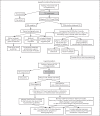2019 European Thyroid Association Guidelines on the Management of Thyroid Dysfunction following Immune Reconstitution Therapy
- PMID: 31602359
- PMCID: PMC6738237
- DOI: 10.1159/000500881
2019 European Thyroid Association Guidelines on the Management of Thyroid Dysfunction following Immune Reconstitution Therapy
Abstract
Thyroid dysfunction (TD) frequently occurs as an autoimmune complication of immune reconstitution therapy (IRT), especially in individuals with multiple sclerosis treated with alemtuzumab, a pan-lymphocyte depleting drug with subsequent recovery of immune cell numbers. Less frequently, TD is triggered by highly active antiretroviral therapy (HAART) in patients infected with human immunodeficiency virus (HIV), or patients undergoing bone-marrow/hematopoietic-stem-cell transplantation (BMT/HSCT). In both alemtuzumab-induced TD and HIV/HAART patients, the commonest disorder is Graves' disease (GD), followed by hypothyroidism and thyroiditis; Graves' orbitopathy is observed in some GD patients. On the contrary, GD is rare post-BMT/HSCT, where hypothyroidism predominates probably as a consequence of the associated radiation damage. In alemtuzumab-induced TD, the autoantibodies against the thyrotropin receptor (TRAb) play a major role, and 2 main aspects distinguish this condition from the spontaneous form: (1) up to 20% of GD cases exhibit a fluctuating course, with alternating phases of hyper- and hypothyroidism, due to the coexistence of TRAb with stimulating and blocking function; (2) TRAb are also positive in about 70% of hypothyroid patients, with blocking TRAb responsible for nearly half of the cases. The present guidelines will provide up-to-date recommendations and suggestions dedicated to all phases of IRT-induced TD: (1) screening before IRT (recommendations 1-3); (2) monitoring during/after IRT (recommendations 4-7); (3) management of TD post-IRT (recommendations 8-17). The clinical management of IRT-induced TD, and in particular GD, can be challenging. In these guidelines, we propose a summary algorithm which has particular utility for nonspecialist physicians and which is tailored toward management of alemtuzumab-induced TD. However, we recommend prompt referral to specialist endocrinology services following diagnosis of any IRT-induced TD diagnosis, and in particular for pregnant women and those considering pregnancy.
Keywords: Alemtuzumab; Autoimmune hypothyroidism; Autoimmune thyroid disease; Autoimmunity; European thyroid association; Graves' disease; Guidelines; Hashimoto's thyroiditis; Highly active antiretroviral therapy; Hyperthyroidism; Hypothyroidism; Immune reconstitution; Management; Thyroid; Treatment.
Copyright © 2019 by S. Karger AG, Basel.
Conflict of interest statement
J.J. is Wellcome Trust funded (grant number RG79413).
Figures


References
-
- Prummel MF, Laurberg P. Interferon-alpha and autoimmune thyroid disease. Thyroid. 2003 Jun;13((6)):547–551. - PubMed
-
- Atkins MB, Mier JW, Parkinson DR, Gould JA, Berkman EM, Kaplan MM. Hypothyroidism after treatment with interleukin-2 and lymphokine-activated killer cells. N Engl J Med. 1988 Jun;318((24)):1557–63. - PubMed
-
- Badros AZ, Siegel E, Bodenner D, Zangari M, Zeldis J, Barlogie B, et al. Hypothyroidism in patients with multiple myeloma following treatment with thalidomide. Am J Med. 2002 Apr;112((5)):412–3. - PubMed
-
- Hancock SL, McDougall IR, Constine LS. Thyroid abnormalities after therapeutic external radiation. Int J Radiat Oncol Biol Phys. 1995 Mar;31((5)):1165–70. - PubMed

